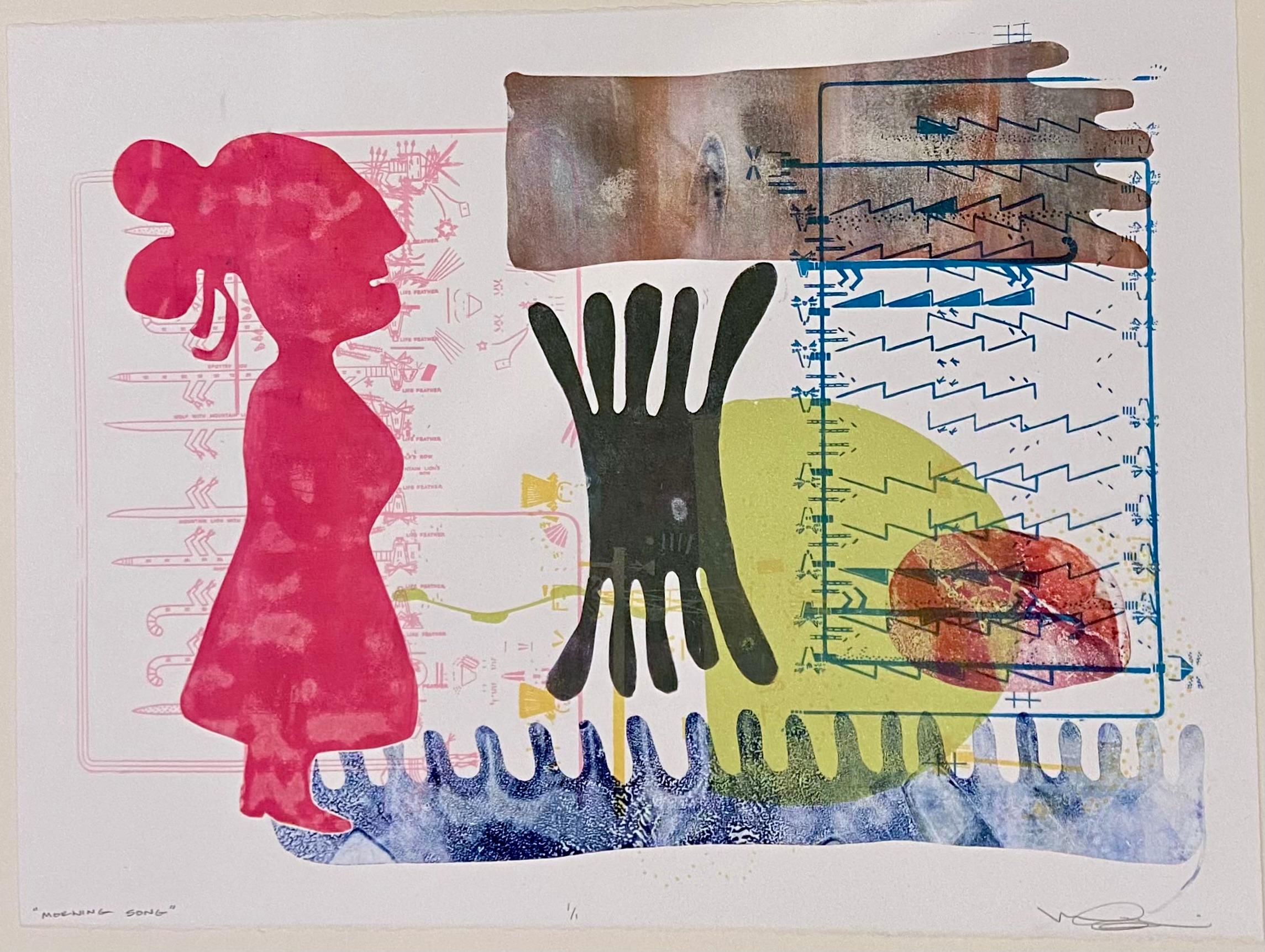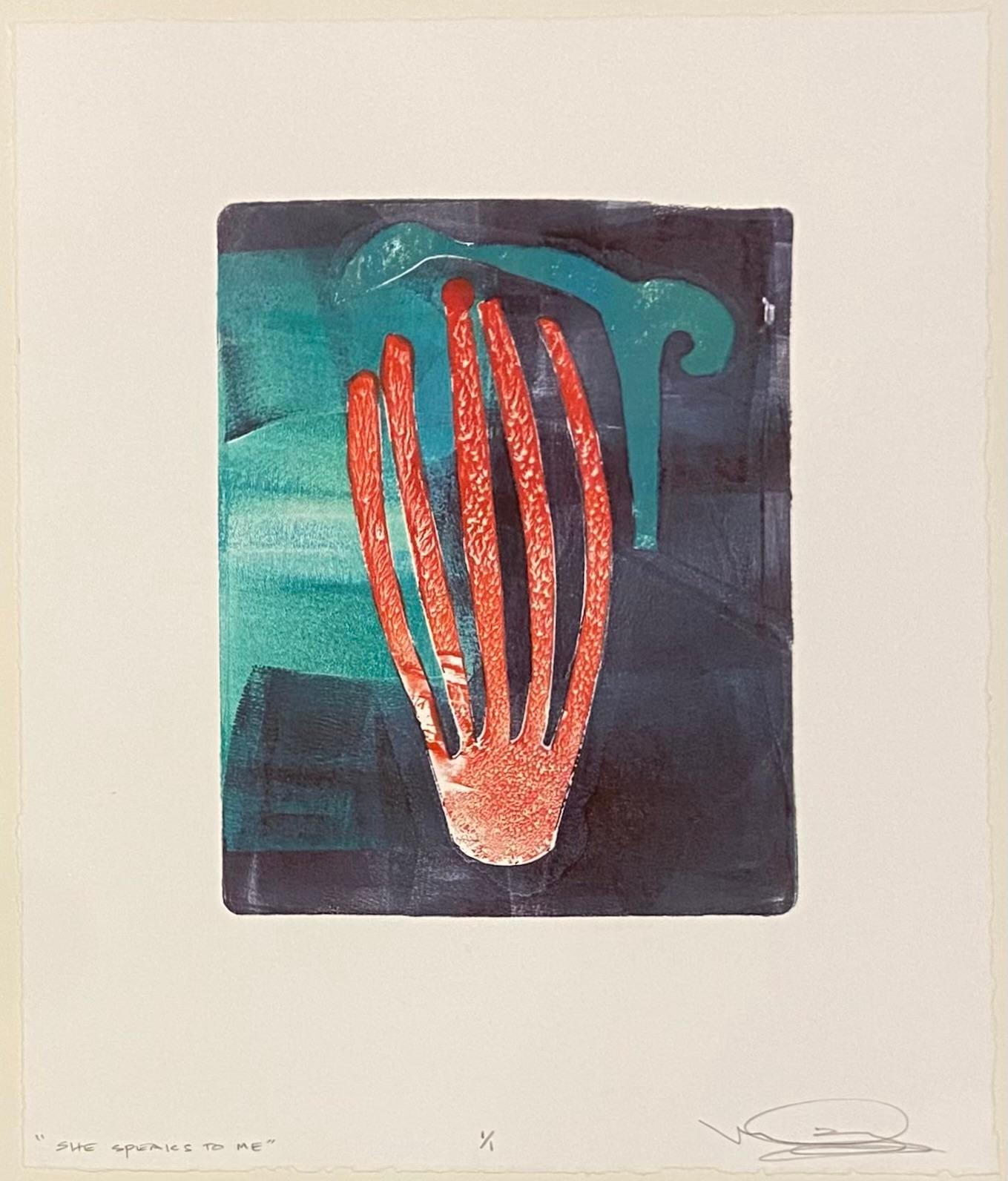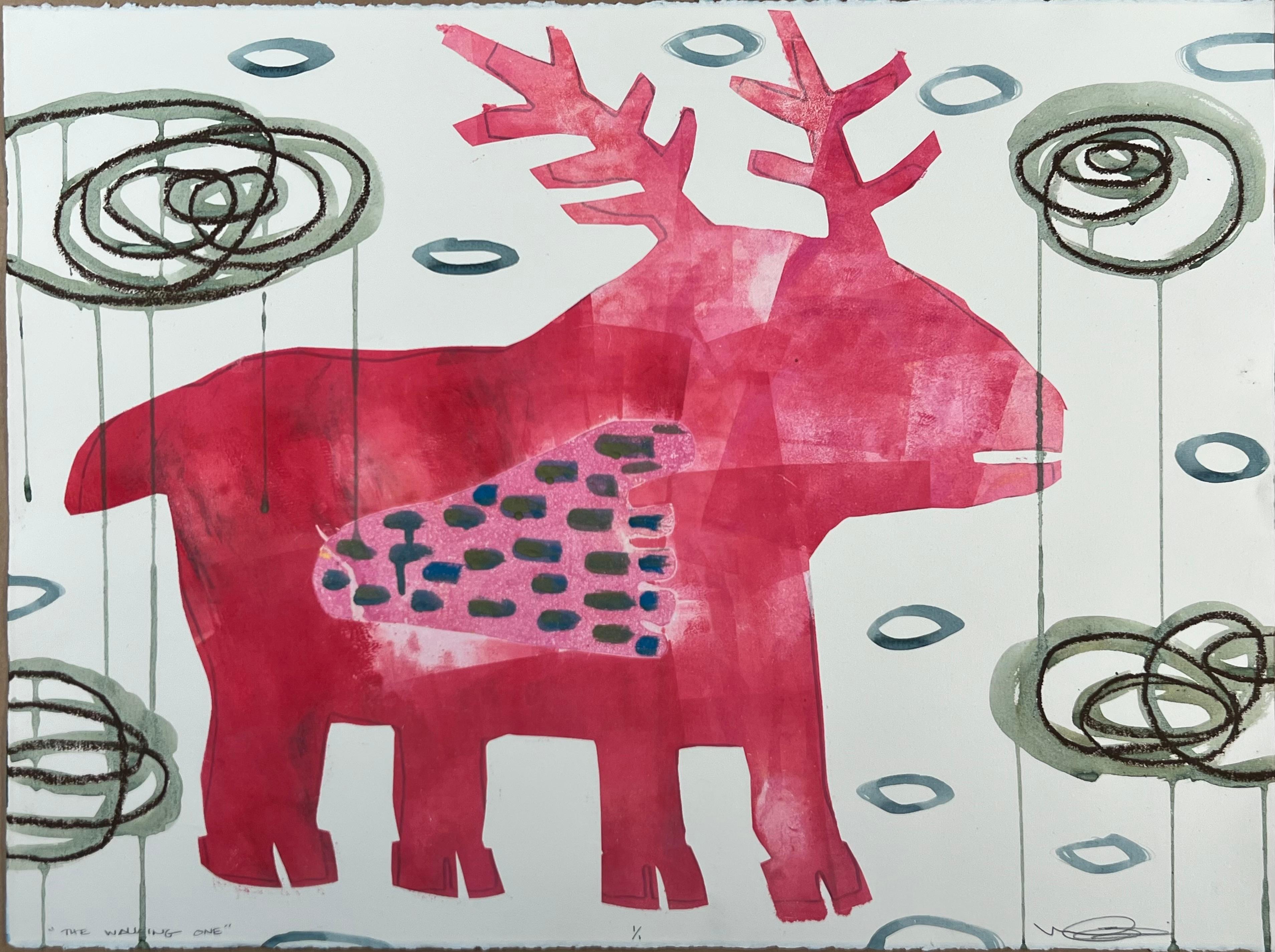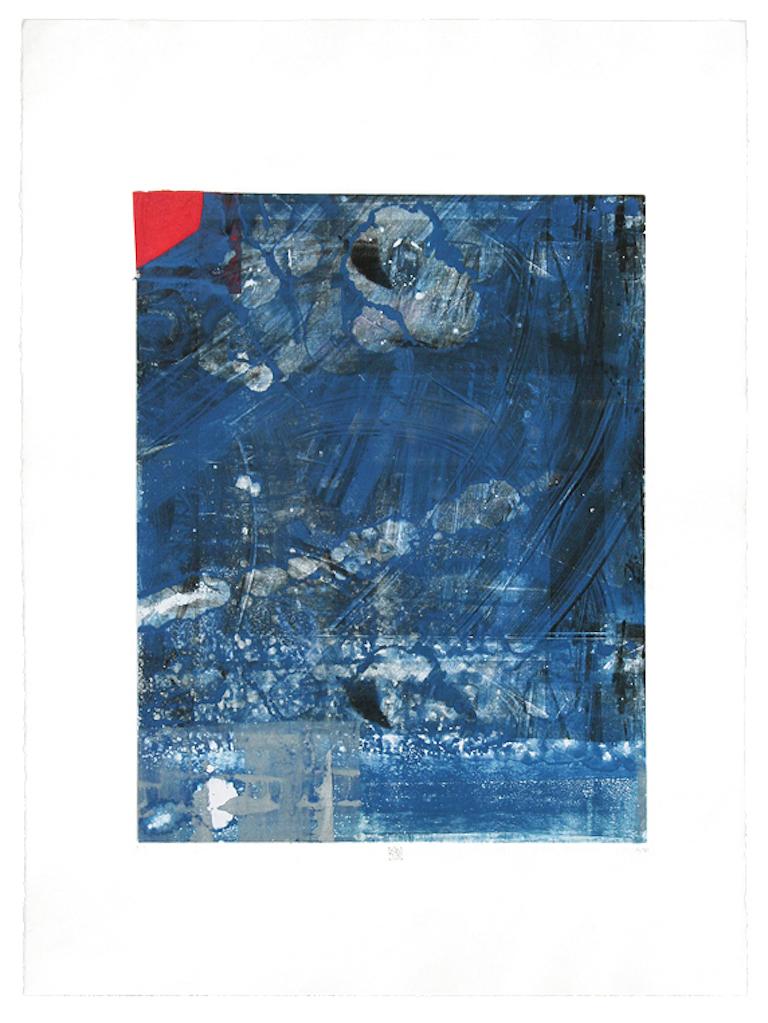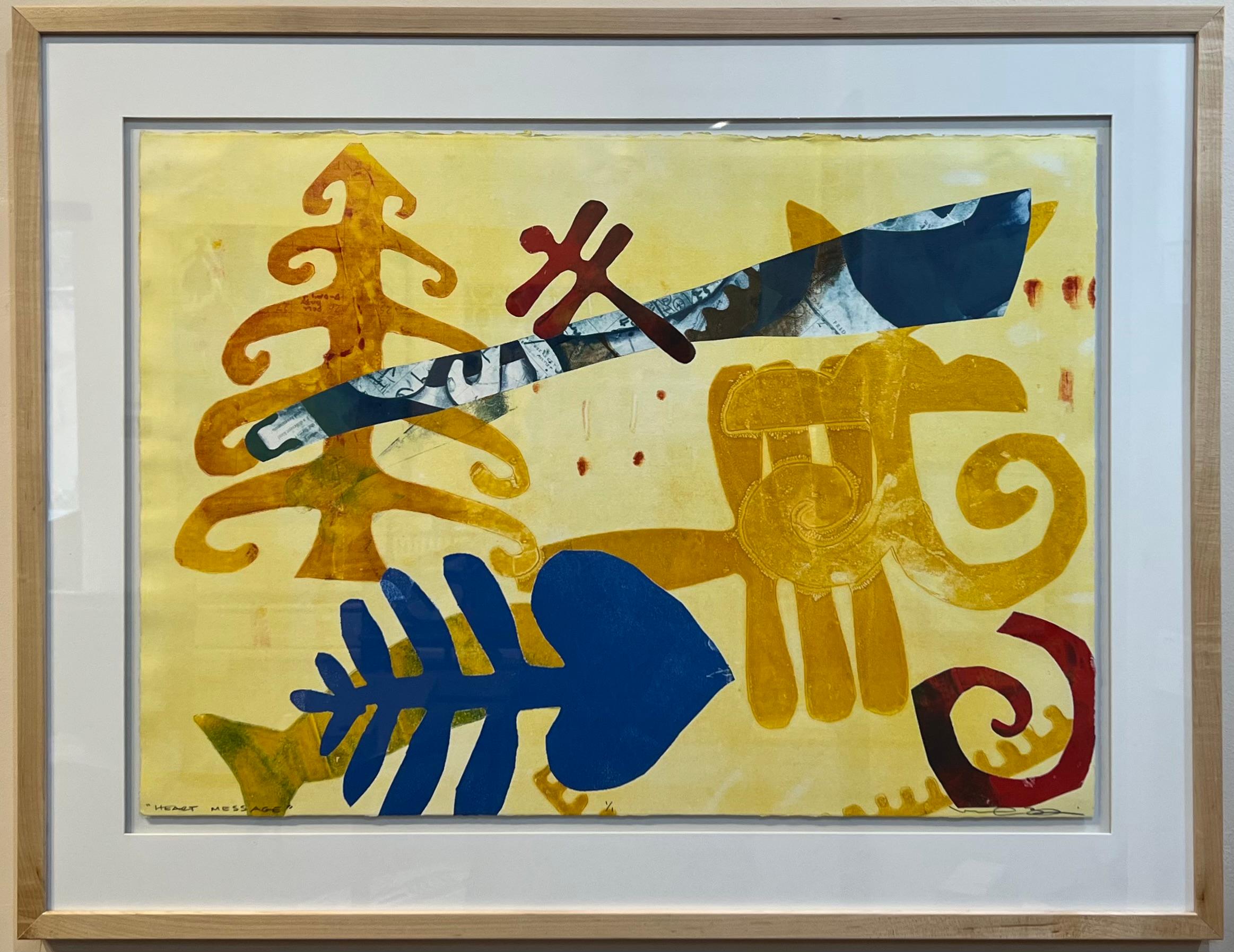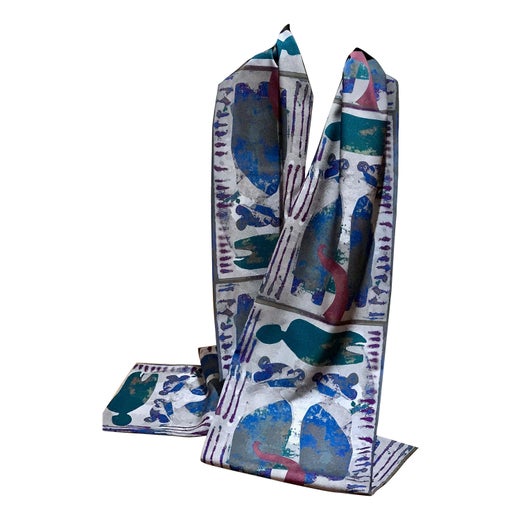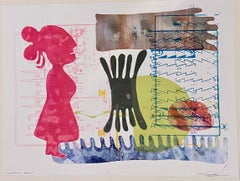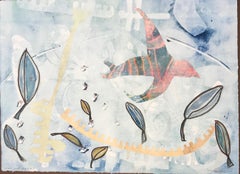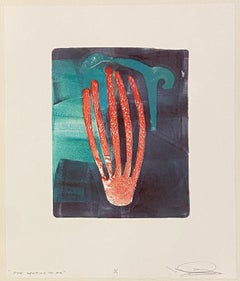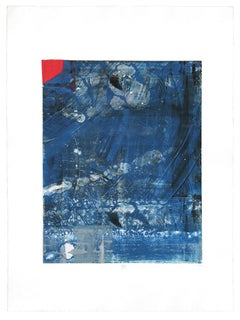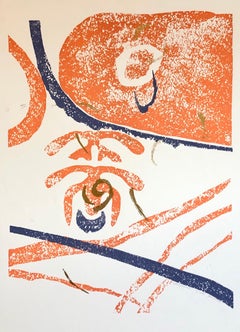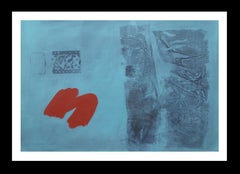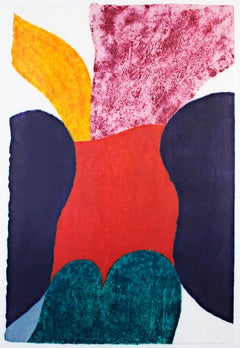Items Similar to Different Directions by Melanie Yazzie, monotype, fish, bird, blue, red, gold
Want more images or videos?
Request additional images or videos from the seller
1 of 8
Melanie YazzieDifferent Directions by Melanie Yazzie, monotype, fish, bird, blue, red, gold
Price Upon Request
Price Upon Request
Price Upon Request
Price Upon Request
Price Upon Request
Price Upon Request
Price Upon Request
Price Upon Request
Price Upon Request
Price Upon Request
About the Item
Different Directions by Melanie Yazzie, monotype, fish, bird, blue,red,gold
unframed, unique monotype
As a printmaker, painter, and sculptor, my work draws upon my rich Diné (Navajo) heritage. The work I make attempts to follows the Diné dictum “walk in beauty” literally, creating beauty and harmony. As an artist, I work to serve as an agent of change by encouraging others to learn about social, cultural, and political phenomena shaping the contemporary lives of Native peoples in the United States and beyond. My work incorporates both personal experiences as well as the events and symbols from Dine culture. My early work focused on depictions of the harsh realities of Native peoples (i.e., racism, identity conflict, poverty, abuse, etc.) to bring to Native issues to the forefront, but more recently I have been making work with a positive twist. Due to personal health issues and trying to live a calmer life style, I have been focusing on quiet and balance. I believe my work is reflecting this shift. The work is also informed and shaped by personal experiences and tries to tell many stories about things both real and imagined. Melanie Yazzie exhibits internationally and has is represented exclusively by our gallery 1995. She is a Professor and Head of Printmaking in the Department of Art and Art History at University of Colorado, Boulder, Colorado. Monotypes are prized because of their unique textural qualities. They are made by drawing on glass or a plate of smooth metal or stone with a greasy substance such as printer's ink or oil paint. Then the drawing is pressed by hand onto a sheet of absorbent paper or is printed on an etching press. Monotypes are one-of-a kind works of art. (Not part of an edition.)
- Creator:Melanie Yazzie (1966, American)
- Dimensions:Height: 22 in (55.88 cm)Width: 30 in (76.2 cm)
- Medium:
- Movement & Style:
- Period:
- Condition:
- Gallery Location:Santa Fe, NM
- Reference Number:1stDibs: LU19125199331
Melanie Yazzie
Melanie Yazzie is an American sculptor, painter and printmaker, born in 1966, in Ganado, Arizona. She first studied art at the Westtown School in Pennsylvania. She has received a BA degree in studio art with a minor in Spanish from Arizona State University, in 1990 and an MFA degree in printmaking from the University of Colorado, at Boulder, in 1993.
About the Seller
4.9
Vetted Professional Seller
Every seller passes strict standards for authenticity and reliability
Established in 1966
1stDibs seller since 2015
101 sales on 1stDibs
Typical response time: 1 hour
- ShippingRetrieving quote...Shipping from: Santa Fe, NM
- Return Policy
Authenticity Guarantee
In the unlikely event there’s an issue with an item’s authenticity, contact us within 1 year for a full refund. DetailsMoney-Back Guarantee
If your item is not as described, is damaged in transit, or does not arrive, contact us within 7 days for a full refund. Details24-Hour Cancellation
You have a 24-hour grace period in which to reconsider your purchase, with no questions asked.Vetted Professional Sellers
Our world-class sellers must adhere to strict standards for service and quality, maintaining the integrity of our listings.Price-Match Guarantee
If you find that a seller listed the same item for a lower price elsewhere, we’ll match it.Trusted Global Delivery
Our best-in-class carrier network provides specialized shipping options worldwide, including custom delivery.More From This Seller
View AllMorning Song, by Melanie Yazzie, work on paper, monotype, female, red, blue
By Melanie Yazzie
Located in Santa Fe, NM
Morning Song, by Melanie Yazzie, work on paper, monotype, female, red, blue
Category
2010s Contemporary Mixed Media
Materials
Archival Ink, Archival Paper
Dry and Moist, by Melanie Yazzie, monotype, pastels, blues, bird, pink, leaves
By Melanie Yazzie
Located in Santa Fe, NM
Dry and Moist, by Melanie Yazzie, monotype, pastels, blues, bird, pink, leaves
unique unframed monotype
As a printmaker, painter, and sculptor, my work draws upon my rich Diné (Navaj...
Category
2010s Contemporary Abstract Prints
Materials
Monotype
She Speaks To Me, by Melanie Yazzie, monotype, abstract, red, blue, framed
By Melanie Yazzie
Located in Santa Fe, NM
She Speaks To Me, by Melanie Yazzie, monotype, abstract, red, blue, framed
Category
2010s Contemporary Mixed Media
Materials
Monotype
The Walking One, mixed media, monotype, by Melanie Yazzie, Navajo, animal, red
By Melanie Yazzie
Located in Santa Fe, NM
The Walking One, mixed media, monotype, by Melanie Yazzie, Navajo, animal, red
As a printmaker, painter, and sculptor, my work draws upon my rich Diné (Navajo) heritage. The work I ...
Category
2010s Contemporary Mixed Media
Materials
Oil Pastel, Watercolor, Monotype
Heart Message, by Melanie Yazzie, work on paper, framed, yellow, abstract, blue
By Melanie Yazzie
Located in Santa Fe, NM
Framed work on paper with monotype elements
Hand pulled and painted 1/1 unique work of art
As a printmaker, painter, and sculptor, my work draws upon my rich Diné (Navajo) heritage....
Category
2010s Contemporary Mixed Media
Materials
Plexiglass, Mixed Media, Archival Paper, Monotype
Growing Strong, by Melanie Yazzie, Native American, monotype, green, black, bird
By Melanie Yazzie
Located in Santa Fe, NM
Growing Strong, by Melanie Yazzie, Native American, monotype, green, black, bird
natural wood frame 27.25" x 35.25"
paper size 20" x 28"
Category
2010s Contemporary Abstract Prints
Materials
Monotype, Archival Paper
You May Also Like
RedHerring, mixed media monotype on paper, abstract blue and red
By Karin Bruckner
Located in New York, NY
Monotype with chine collé on white BFK Rives Printmaking Paper.
Approx image size: 20" x 15.75"
Paper: 30" x 22"
At the core of the dialogue between the artist and the work is an ...
Category
2010s Contemporary Abstract Prints
Materials
Paper, Mixed Media, Monotype
Motif, Gold Abstract African American Artist Viola Leak Woodcut Silkscreen Print
By Viola Burley Leak
Located in Surfside, FL
Motif (Abstract) in orange, blue and gold abstract.
From the small edition of 10. from 1982. I am not sure if this is a woodcut or woodblock print or a silkscreen screenprint or some combination.
Viola Burley Leak, American (1944 - )
Viola Leak was born in Nashville, Tennessee, she received a B.A. in Art from Fisk University, a B.F.A. in Fashion Design from Pratt Institute, Brooklyn, an M.A. from Hunter College, NY and an M.F.A. in Media from Howard University, Washington, DC. Leak was an art consultant for both the New York State Board of Education and the Metropolitan Museum of Art's Print Department, in addition to working for the Experimental Gallery of Art at the Smithsonian Institute. Her mixed media work often references religious motifs and those of her African-American experience and heritage.
She is a multimedia artist, her works include printmaking, textile designing, soft sculpture, appliqué tapestries, doll making, and multi-media.
Viola has studied with many renowned artists such as Aaron Douglas, Romare Bearden, Robert Blackburn, and Charles White. Her works can be found in the collections of World Federation of United Nations, New York State Office Building, Manufacturers of Hanover Trust Company, Atlanta Life Insurance Company and many more organizations.
Viola's exhibition experience is extensive - more than 100 showings over a decade, national and international. Her quilts exude a miraculous and magical presence. They have traveled in two international shows and three national quilt projects in the past three years.
A proud moment for her was being featured in the December 20, 2000 of the Smithsonian magazine; the article praised her mural "Afro Dance Scan" as one of the outstanding artworks in the "When the Spirit Moves: African American Dance...
Category
1980s Contemporary Figurative Prints
Materials
Screen, Woodcut
Ruz Blue and Red abstract Landscapes Abstract Acrylic on paper
By Rafael Ruz
Located in CORAL GABLES - MIAMI, FL
Original work of the artist RUZ.. framed
Acrylic on paper
Perfect state
virtual frame
While contemplating the painting of Ruz, we are inclined to talk about real ‘psychodrama’, in th...
Category
21st Century and Contemporary Abstract Abstract Paintings
Materials
Paper, Acrylic
"India, " Abstract Woodcut and Monotype signed by Carol Summers
By Carol Summers
Located in Milwaukee, WI
"India" is a woodcut and monotype signed by Carol Summers. Here, Summer's abstract language for landscape imagery is taken to its most extreme: The image offers a view of a highly stylized waterfall, with red water falling down behind green foliage below. A hint of light blue at the lower left suggests a continuation of the water's flow. Above, purples and yellows mist upward from the power of the water. The playfulness of the image is enhanced by Summers' signature printmaking technique, which allows the ink from the woodblock to seep through the paper, blurring the edges of each form. Summers' signature can be found in pencil at the bottom of the rightmost blue form, with the title and edition at the bottom of the leftmost blue form. A copy of this print can be found in the collection of the Fine Arts Museums of San Francisco.
37.25 x 24.88 inches, artwork
48.5 x 35.5 inches, frame
Numbered 44 from the edition of 75
Carol Summers (1925-2016) has worked as an artist throughout the second half of the 20th century and into the first years of the next, outliving most of his mid-century modernist peers. Initially trained as a painter, Summers was drawn to color woodcuts around 1950 and it became his specialty thereafter. Over the years he has developed a process and style that is both innovative and readily recognizable. His art is known for it’s large scale, saturated fields of bold color, semi-abstract treatment of landscapes from around the world and a luminescent quality achieved through a printmaking process he invented.
In a career that has extended over half a century, Summers has hand-pulled approximately 245 woodcuts in editions that have typically run from 25 to 100 in number. His talent was both inherited and learned. Born in 1925 in Kingston, a small town in upstate New York, Summers was raised in nearby Woodstock with his older sister, Mary. His parents were both artists who had met in art school in St. Louis. During the Great Depression, when Carol was growing up, his father supported the family as a medical illustrator until he could return to painting. His mother was a watercolorist and also quite knowledgeable about the different kinds of papers used for various kinds of painting. Many years later, Summers would paint or print on thinly textured paper originally collected by his mother.
From 1948 to 1951, Carol Summers trained in the classical fine and studio arts at Bard College and at the Art Students League of New York. He studied painting with Steven Hirsh and printmaking with Louis Schanker. He admired the shapes and colors favored by early modernists Paul Klee (Sw: 1879-1940) and Matt Phillips (Am: b.1927- ). After graduating, Summers quit working as a part-time carpenter and cabinetmaker (which had supported his schooling and living expenses) to focus fulltime on art. That same year, an early abstract, Bridge No. 1 was selected for a Purchase Prize in a competition sponsored by the Brooklyn Museum.
In 1952, his work (Cathedral, Construction and Icarus) was shown the first time at the Museum of Modern Art in New York City in an exhibition of American woodcuts. In 1954, Summers received a grant from the Italian government to study for a year in Italy. Woodcuts completed soon after his arrival there were almost all editions of only 8 to 25 prints, small in size, architectural in content and black and white in color. The most well-known are Siennese Landscape and Little Landscape, which depicted the area near where he resided. Summers extended this trip three more years, a decision which would have significant impact on choices of subject matter and color in the coming decade.
After returning from Europe, Summers’ images continued to feature historical landmarks and events from Italy as well as from France, Spain and Greece. However, as evidenced in Aetna’s Dream, Worldwind and Arch of Triumph, a new look prevailed. These woodcuts were larger in size and in color. Some incorporated metal leaf in the creation of a collage and Summers even experimented with silkscreening. Editions were now between 20 and 50 prints in number. Most importantly, Summers employed his rubbing technique for the first time in the creation of Fantastic Garden in late 1957.
Dark Vision of Xerxes, a benchmark for Summers, was the first woodcut where Summers experimented using mineral spirits as part of his printmaking process. A Fulbright Grant as well as Fellowships from the Louis Comfort Tiffany Foundation and the Guggenheim Foundation followed soon thereafter, as did faculty positions at colleges and universities primarily in New York and Pennsylvania. During this period he married a dancer named Elaine Smithers with whom he had one son, Kyle. Around this same time, along with fellow artist Leonard Baskin, Summers pioneered what is now referred to as the “monumental” woodcut. This term was coined in the early 1960s to denote woodcuts that were dramatically bigger than those previously created in earlier years, ones that were limited in size mostly by the size of small hand-presses. While Baskin chose figurative subject matter, serious in nature and rendered with thick, striated lines, Summers rendered much less somber images preferring to emphasize shape and color; his subject matter approached abstraction but was always firmly rooted in the landscape.
In addition to working in this new, larger scale, Summers simultaneously refined a printmaking process which would eventually be called the “Carol Summers Method” or the “ Carol Summers Technique”. Summers produces his woodcuts by hand, usually from one or more blocks of quarter-inch pine, using oil-based printing inks and porous mulberry papers. His woodcuts reveal a sensitivity to wood especially its absorptive qualities and the subtleties of the grain. In several of his woodcuts throughout his career he has used the undulating, grainy patterns of a large wood plank to portray a flowing river or tumbling waterfall. The best examples of this are Dream, done in 1965 and the later Flash Flood Escalante, in 2003. In the majority of his woodcuts, Summers makes the blocks slightly larger than the paper so the image and color will bleed off the edge.
Before printing, he centers a dry sheet of paper over the top of the cut wood block or blocks, securing it with giant clips. Then he rolls the ink directly on the front of the sheet of paper and pressing down onto the dry wood block or reassembled group of blocks. Summers is technically very proficient; the inks are thoroughly saturated onto the surface of the paper but they do not run into each other. The precision of the color inking in Constantine’s Dream in 1969 and Rainbow Glacier in 1970 has been referred to in various studio handbooks. Summers refers to his own printing technique as “rubbing”. In traditional woodcut printing, including the Japanese method, the ink is applied directly onto the block. However, by following his own method, Summers has avoided the mirror-reversed image of a conventional print and it has given him the control over the precise amount of ink that he wants on the paper. After the ink is applied to the front of the paper, Summers sprays it with mineral spirits, which act as a thinning agent. The absorptive fibers of the paper draw the thinned ink away from the surface softening the shapes and diffusing and muting the colors. This produces a unique glow that is a hallmark of the Summers printmaking technique. Unlike the works of other color field artists or modernists of the time, this new technique made Summers’ extreme simplification and flat color areas anything but hard-edged or coldly impersonal.
By the 1960s, Summers had developed a personal way of coloring and printing and was not afraid of hard work, doing the cutting, inking and pulling himself. In 1964, at the age of 38, Summers’ work was exhibited for a second time at the Museum of Modern Art. This time his work was featured in a one-man show and then as one of MoMA’s two-year traveling exhibitions which toured throughout the United States. In subsequent years, Summers’ works would be exhibited and acquired for the permanent collections of multiple museums throughout the United States, Europe and Asia. Summers’ familiarity with landscapes throughout the world is firsthand. As a navigator-bombardier in the Marines in World War II, he toured the South Pacific and Asia.
Following college, travel in Europe and subsequent teaching positions, in 1972, after 47 years on the East Coast, Carol Summers moved permanently to Bonny Doon in the Santa Cruz Mountains in Northern California. There met his second wife, Joan Ward Toth, a textile artist who died in 1998; and it was here his second son, Ethan was born. During the years that followed this relocation, Summers’ choice of subject matter became more diverse although it retained the positive, mostly life-affirming quality that had existed from the beginning. Images now included moons, comets, both sunny and starry skies, hearts and flowers, all of which, in one way or another, remained tied to the landscape.
In the 1980s, from his home and studio in the Santa Cruz mountains, Summers continued to work as an artist supplementing his income by conducting classes and workshops at universities in California and Oregon as well as throughout the Mid and Southwest. He also traveled extensively during this period hiking and camping, often for weeks at a time, throughout the western United States and Canada. Throughout the decade it was not unusual for Summers to backpack alone or with a fellow artist into mountains or back country for six weeks or more at a time. Not surprisingly, the artwork created during this period rarely departed from images of the land, sea and sky. Summers rendered these landscapes in a more representational style than before, however he always kept them somewhat abstract by mixing geometric shapes with organic shapes, irregular in outline. Some of his most critically acknowledged work was created during this period including First Rain, 1985 and The Rolling Sea, 1989. Summers received an honorary doctorate from his alma mater, Bard College in 1979 and was selected by the United States Information Agency to spend a year conducting painting and printmaking workshops at universities throughout India. Since that original sabbatical, he has returned every year, spending four to eight weeks traveling throughout that country.
In the 1990s, interspersed with these journeys to India have been additional treks to the back roads and high country areas of Mexico, Central America, Nepal, China and Japan. Travel to these exotic and faraway places had a profound influence on Summers’ art. Subject matter became more worldly and nonwestern as with From Humla to Dolpo, 1991 or A Former Life of Budha, 1996, for example. Architectural images, such as The Pillars of Hercules, 1990 or The Raja’s Aviary, 1992 became more common. Still life images made a reappearance with Jungle Bouquet in 1997. This was also a period when Summers began using odd-sized paper to further the impact of an image.
The 1996 Night, a view of the earth and horizon as it might be seen by an astronaut, is over six feet long and only slightly more than a foot-and-a-half high. From 1999, Revuelta A Vida (Spanish for “Return to Life”) is pie-shaped and covers nearly 18 cubic feet. It was also at this juncture that Summers began to experiment with a somewhat different palette although he retained his love of saturated colors. The 2003 Far Side of Time is a superb example of the new direction taken by this colorist.
At the turn of the millennium in 1999, “Carol Summers Woodcuts...
Category
1990s Contemporary Abstract Prints
Materials
Monotype, Woodcut
"Through the Glass" Colorful, Abstract Monotype Print
Located in New York, NY
Through the Glass
Monotype print
Natasha Karpinskaia's paintings are characterized by their vibrant colors, bold shapes, and dynamic compositions. She uses a variety of media, inclu...
Category
2010s Abstract Abstract Prints
Materials
Paint, Paper, Monoprint, Monotype
Pilot's Notion Four, Geometric Abstract Monotype, Navy Blue, Red, Yellow
By David Collins
Located in Kent, CT
This is a monotype, a unique print with no other editions. This geometric abstract monotype on paper layers shapes on a blue background that transitions from deep, dark cobalt on the...
Category
Early 2000s Contemporary Abstract Prints
Materials
Archival Paper, Monotype
